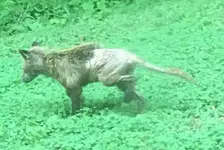You are using an out of date browser. It may not display this or other websites correctly.
You should upgrade or use an alternative browser.
You should upgrade or use an alternative browser.
Wht the heck is wrong with this poor fox? .. or is it a chupacabra??
- Thread starter creskol
- Start date
Mange?
- Joined
- May 28, 2010
- Messages
- 20,456
- Reaction score
- 32,621
- Golden Thread
- 1
- Location
- White Plains, New York
- 🥇 Banner finds
- 1
- 🏆 Honorable Mentions:
- 1
- Detector(s) used
- Nokta Makro Legend// Pulsedive// Minelab GPZ 7000// Vanquish 540// Minelab Pro Find 35// Dune Kraken Sandscoop// Grave Digger Tools Tombstone shovel & Sidekick digger// Bunk's Hermit Pick
- Primary Interest:
- Metal Detecting
[h=2]Rabies and mange in foxes[/h]Foxes aren't dangerous to humans, except when they are rabid, which is very rare. Although foxes sometimes succumb to rabies, the good news is that the fox strain of the disease has rarely if ever been transmitted to a human in this country. Luckily, post-exposure treatment is 100% effective if promptly administered. Having your domestic animals vaccinated is the most important thing you can do to protect them, yourself and others against rabies.
It’s not all that unusual for a fox to be seen out and about during the day, so that is not cause for concern. Foxes prey on squirrels, birds, chipmunks and other animals that are only active by day, so they may simply be looking for a meal at that time. Before calling to report a fox or ask for assistance, take time to observe the fox's behavior, and look for these signs:
https://www.humanesociety.org/resources/what-do-about-foxes
It’s not all that unusual for a fox to be seen out and about during the day, so that is not cause for concern. Foxes prey on squirrels, birds, chipmunks and other animals that are only active by day, so they may simply be looking for a meal at that time. Before calling to report a fox or ask for assistance, take time to observe the fox's behavior, and look for these signs:
- Partial paralysis or the inability to use their limbs well.
- Circling or staggering as if drunk.
- Self-mutilation.
- Acting aggressively for no reason.
- Acting unnaturally tame.
https://www.humanesociety.org/resources/what-do-about-foxes
GB1
Gold Member
i would stay away from that thing
Ahab8
Gold Member
- Joined
- Oct 15, 2013
- Messages
- 8,408
- Reaction score
- 8,289
- Golden Thread
- 2
- Location
- Topsham, Maine
- 🥇 Banner finds
- 2
- Detector(s) used
- Teknetics T2 SE w/15' SEF Coil/ Minelab GPX 4500/2 Garrett Pro Pointers/3 Sets Killer B Headphones/ Koss Headphones/ Detekniy Wireless headphone Adapter
- Primary Interest:
- All Treasure Hunting
It’s not too abnormal this time of year to see a fox missing giant clumps of fur as they shed their winter coat. They can look pretty nasty during that period. We had 7 or 8 rabid fox attacks on people in my area last year. If they’re rabid they are normally very aggressive
- Joined
- Aug 3, 2017
- Messages
- 4,740
- Reaction score
- 6,582
- Golden Thread
- 0
- Location
- Northern Virginia
- 🏆 Honorable Mentions:
- 1
- Detector(s) used
- AT MAX/AT PRO/GPX-4500, Equinox 800, Garrett Pro Pointer,NEL Attack Coil, Lesche diggers, and the custom made in the USA Freeloader Pack Mule Pouch!
- Primary Interest:
- All Treasure Hunting
It looks mangy but like Ahab says they can look pretty gnarly when shedding off the winter coat. I have seen some fugly ones around here.
firemanphob
Bronze Member
- Joined
- Apr 8, 2018
- Messages
- 1,080
- Reaction score
- 2,024
- Golden Thread
- 0
- Location
- Lanesville, IN
- Detector(s) used
- White Coin master 4000
Garrett AT PRO
- Primary Interest:
- All Treasure Hunting
I would say mange. Would probably put it out of its misery. Probably going to die a slow death.
DizzyDigger
Gold Member
- Joined
- Dec 9, 2012
- Messages
- 6,945
- Reaction score
- 14,988
- Golden Thread
- 0
- Location
- Concrete, WA
- Detector(s) used
- Nokta FoRs Gold, a Gold Cube, 2 Keene Sluices and Lord only knows how many pans....not to mention a load of other gear my wife still doesn't know about!
- Primary Interest:
- Prospecting
Get on the horn tomorrow morning to your local animal rehab facility.
They may come and pick it up, treat it for the mange, then release
it back to the wild. Worst case they may have to put it down, but
at least it'll be done humanely.
They may come and pick it up, treat it for the mange, then release
it back to the wild. Worst case they may have to put it down, but
at least it'll be done humanely.
TooManyHobbies
Bronze Member
Definitely a bad case of mange. Poor thing needs to be put down. The longer it survives, the more it can spread to other foxes, etc. Nature can be cruel.
Megalodon
Silver Member
Looks more like mange than shedding winter coat - which is usually more clumpy. Mange can be treated, but good luck finding anyone caring enough to do it.
Kansas_Jayhawk
Full Member
- Joined
- Mar 11, 2017
- Messages
- 161
- Reaction score
- 178
- Golden Thread
- 0
- Location
- Southcentral Kansas
- Detector(s) used
- Fisher F75 and Tesoro Silver uMicromax
- Primary Interest:
- All Treasure Hunting
My suggestion if you see it again contact animal control or conservation officer so they can take care of the animal.
creskol
Gold Member
- #16
Thread Owner
Ivermectin therapy, is that easy to use
i know some barn cats with mange, could it help cats too
I am using injectable Ivermectin and putting in a hotdog which has proven effective in foxes: "Although it is an “off-label use” according to the FDA, Ivermectin injection for cattle and pigs is a very effective cure for Sarcoptic mange in foxes. This injectable solution works orally and can easily be slipped into food. The ivermectin also treats a lot of the intestinal worms and any ear mites."
I know they use Ivermectin for cats , too, although you would have to research it to find out how it is administered and what the dosage would be.
Last edited:
diggummup
Platinum Member
- Joined
- Jul 15, 2004
- Messages
- 17,824
- Reaction score
- 10,135
- Golden Thread
- 0
- Location
- Somewhere in the woods
- Detector(s) used
- Whites M6
- Primary Interest:
- All Treasure Hunting
Trying to cure a chupacabra of mange. Kudos to you! 

glass half fool
Bronze Member
- Joined
- Jul 17, 2017
- Messages
- 1,108
- Reaction score
- 1,991
- Golden Thread
- 0
- Location
- North of the Mason Dixon line
- Detector(s) used
- White 5900DiPro
- Primary Interest:
- All Treasure Hunting
Mange is a disease caused by mites in the hair follicle of the animal . It is common with foxes and in some cases black bear .It is spread through contact between animals . Often they use the same den or feed on large dead carcasses during the winter months If not treated the animal generally dies .It is one way that Mother Nature controls over population .Rabies, distemper, parvo ,and internal parasites are others .Some of these diseases came be contacted by people or their pets . It turns my stomach to see and animal up close with this type of diease
fistfulladirt
Gold Member
- Joined
- Feb 21, 2008
- Messages
- 12,221
- Reaction score
- 4,942
- Golden Thread
- 0
- Location
- Great Lakes State
- 🏆 Honorable Mentions:
- 1
- Detector(s) used
- dirtfishing
- Primary Interest:
- Other
Similar threads
- Replies
- 2
- Views
- 626
- Replies
- 2
- Views
- 501
Users who are viewing this thread
Total: 1 (members: 0, guests: 1)
Latest Discussions
-
-
Confederate Gold from the Civil War was Found in a Shocking Place
- Latest: achanceforgold
-
-








